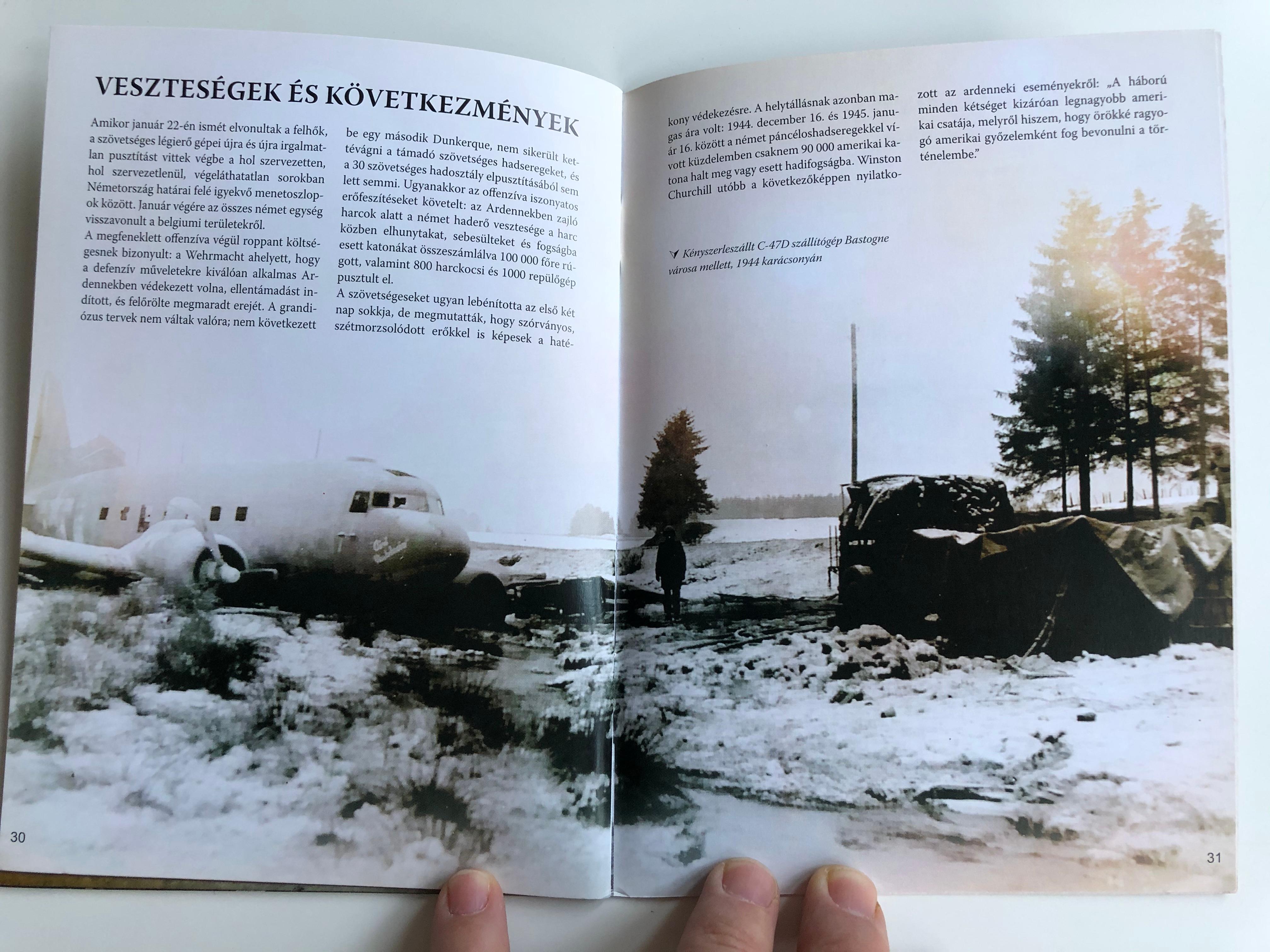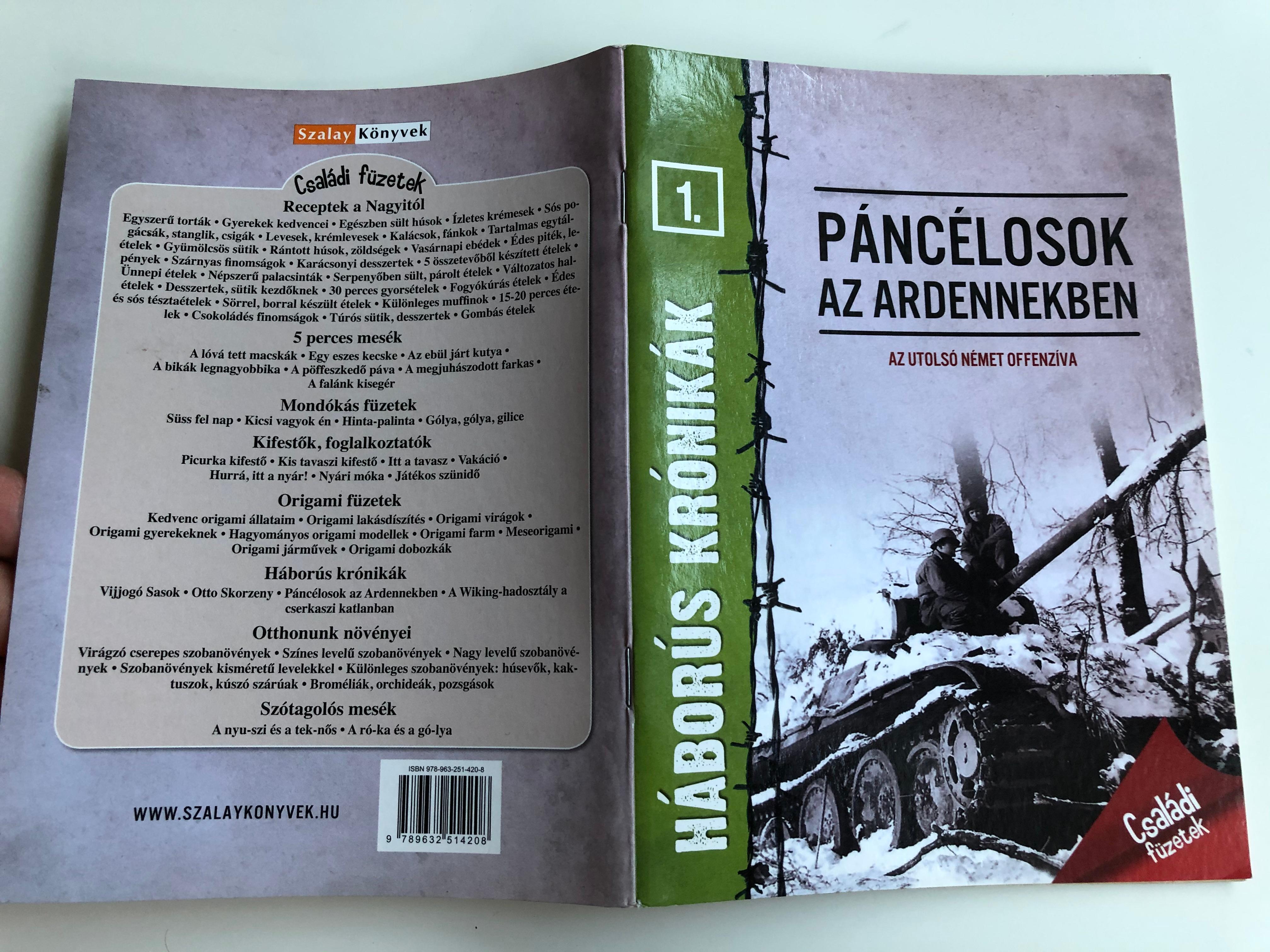Product Overview
Páncélosok az Ardennekben - Az utolsó német offenzíva by Szirtes Krisztián / Panzers in the Ardennes - The Last German Offensive / Hungarian WW2 Booklet / Pannon-Literatúra - Szalay könyvek / Háborús krónikák 1.
Paperback 2012
PAGES: 32
ISBN: 9789632514208 / 978-9632514208
ISBN-10: 9632514181
PUBLISHER: Pannon-Literatúra
LANGUAGE: Hungarian / Magyar
Hungarian Description:
1944 késő őszére a kétfrontos háború csaknem teljesen felőrölte a Harmadik Birodalom hadseregét. Az egykor egész Európát markában tartó Wehrmacht a Vaterland határai mögé szorult, és saját területen kényszerült harcolni, keleten a Vörös Hadsereg, nyugaton pedig az angolszász szövetségesek egyesített hadereje ellen.
1944. június 6-án a szövetséges csapatok partra szálltak Normandiában, és kiépített hídfőállásukból a nyár folyamán egészen a Szajnáig törtek előre. Augusztus 25-én elfoglalták Párizst; az augusztus 29-i győzelmi ünnepségen a Champs-Elysées-n masírozó amerikai katonákat óriási üdvrivalgás fogadta. Szeptember 2-án a brit harckocsik elérték Brüsszelt, és Belgium fővárosa is a szövetségesek kezére került.
English Summary:
The Battle of the Bulge, also known as the Ardennes Counteroffensive, was a major German offensive campaign on the Western Front during World War II, and took place from 16 December 1944 to 25 January 1945. It was launched through the densely forested Ardennes region of Wallonia in eastern Belgium, northeast France, and Luxembourg, towards the end of the war in Europe. The offensive was intended to stop Allied use of the Belgian port of Antwerp and to split the Allied lines, allowing the Germans to encircle and destroy four Allied armies and force the Western Allies to negotiate a peace treaty in the Axis powers' favor.
The Germans achieved a total surprise attack on the morning of 16 December 1944, due to a combination of Allied overconfidence, preoccupation with Allied offensive plans, and poor aerial reconnaissance due to bad weather. American forces bore the brunt of the attack and incurred their highest casualties of any operation during the war. The battle also severely depleted Germany's armored forces, and they were largely unable to replace them. German personnel and, later, Luftwaffe aircraft (in the concluding stages of the engagement) also sustained heavy losses. The Germans had attacked a weakly defended section of the Allied line, taking advantage of heavily overcast weather conditions that grounded the Allies' overwhelmingly superior air forces. Fierce resistance on the northern shoulder of the offensive, around Elsenborn Ridge, and in the south, around Bastogne, blocked German access to key roads to the northwest and west that they counted on for success. Columns of armor and infantry that were supposed to advance along parallel routes found themselves on the same roads. This, and terrain that favored the defenders, threw the German advance behind schedule and allowed the Allies to reinforce the thinly placed troops. The farthest west the offensive reached was the village of Foy-Nôtre-Dame, south east of Dinant, being stopped by the U.S. 2nd Armored Division on 24 December 1944.[15][16][17] Improved weather conditions from around 24 December permitted air attacks on German forces and supply lines, which sealed the failure of the offensive. On 26 December the lead element of Patton's U.S. Third Army reached Bastogne from the south, ending the siege. Although the offensive was effectively broken by 27 December, when the trapped units of 2nd Panzer Division made two break-out attempts with only partial success, the battle continued for another month before the front line was effectively restored to its position prior to the attack. In the wake of the defeat, many experienced German units were left severely depleted of men and equipment, as survivors retreated to the defenses of the Siegfried Line.
Tartalom / Contents:
Németország az összeomlás küszöbén 2
Őszi köd 5
Miért az Ardennek? 6
Hitler legfőbb szövetségese: a meglepetés 8
Sikerek és kudarcok 9
A Peiper-harccsoport tevékenysége 9
Manteuffel "fürge esőcseppjei" 10
Brandenberger 7. hadserege 11
Otto Skorzeny Greif-kommandója 11
Váratlan nehézségek, hátráltató problémák 13
Előjáték Malmédyhez 15
Értelmetlen mészárlás 15
St. Vith és Bastogne 16
Bastogne hősei 17
"Bújjatok elő! Megjöttek a 4-es páncélosok!!!" 19
Elégtelen üzemanyagkészlet és csontrepesztő hideg 20
Tábornokok arcképcsarnoka 21
Német felmentési kísérletek: a Bodenplatte- és a Norwind-hadművelet 25
A mindent eldöntő légi csapás 26
A kiszögellés felszámolása és a vereség következményei 27
Veszteségek és következmények 30






















